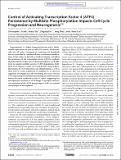Control of Activating Transcription Factor 4 (ATF4) Persistence by Multisite Phosphorylation Impacts Cell Cycle Progression and Neurogenesis
Author(s)
Frank, Christopher Lee; Ge, Xuecai; Xie, Zhigang; Zhou, Ying; Tsai, Li-Huei
DownloadTsai-Control of activating.pdf (4.288Mb)
MIT_AMENDMENT
MIT Amendment
Article is made available in accordance with the publisher's policy and may be subject to US copyright law. Please refer to the publisher's site for terms of use.
Terms of use
Metadata
Show full item recordAbstract
Organogenesis is a highly integrated process with a fundamental requirement for precise cell cycle control. Mechanistically, the cell cycle is composed of transitions and thresholds that are controlled by coordinated post-translational modifications. In this study, we describe a novel mechanism controlling the persistence of the transcription factor ATF4 by multisite phosphorylation. Proline-directed phosphorylation acted additively to regulate multiple aspects of ATF4 degradation. Stabilized ATF4 mutants exhibit decreased β-TrCP degron phosphorylation, β-TrCP interaction, and ubiquitination, as well as elicit early G1 arrest. Expression of stabilized ATF4 also had significant consequences in the developing neocortex. Mutant ATF4 expressing cells exhibited positioning and differentiation defects that were attributed to early G1 arrest, suggesting that neurogenesis is sensitive to ATF4 dosage. We propose that precise regulation of the ATF4 dosage impacts cell cycle control and impinges on neurogenesis.
Description
The on-line version of this article (available at http://www.jbc.org) contains supplemental Figs. S1–S5.
Date issued
2010-08Department
Picower Institute for Learning and MemoryJournal
Journal of Biological Chemistry
Citation
Frank, C. L. et al. “Control of Activating Transcription Factor 4 (ATF4) Persistence by Multisite Phosphorylation Impacts Cell Cycle Progression and Neurogenesis.” Journal of Biological Chemistry 285 (2010): 33324-33337. Web. 30 Nov. 2011. © 2011 by American Society for Biochemistry and Molecular Biology
Version: Final published version
ISSN
0021-9258
1083-351X